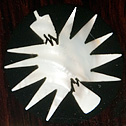| |
Interview with Steve Kimock by Steve Armato

Photo of Kimock at Studio E with his Teak Cripe guitar.
Photo Courtesy of Ed Giguere
Click on pictures to view larger.
Sunday morning, March 22, 2009
Steve Kimock calls on his cell phone from the streets of San Francisco. It is a blustery day and he is on his way to rehearse with Steve Kimock Crazy Engine, which is debuting on the west coast later in the week. He has to duck into an alcove to get out of the wind.
Kimock: Oh, it’s even windier over here! I’m going to go this way.
Armato: Are you enjoying the Bay area?
Kimock: I am. We had a couple of beautiful days, then a very cold, rainy, stormy night last night. It got yucky.
Armato: Well, keep up your resistance!
Kimock: Not a problem, I’m just hanging out here in the doorway of Charles Schwab, he won’t be using it. He’s on the street too!
Armato: How did your first encounter Cripe’s work?
Kimock: My first knowledge of the instruments came though my proximity to the Grateful Dead. I’m kind of a guitar guy, so when Jerry Garcia got a new guitar, and it wasn’t an Irwin, then people around him knew someone flipped him a cool guitar.
Armato: How did you first get yours?
Kimock: Mine was a gift from some fans, believe it or not. When I was pressed into service for “The Other Ones” gig, for the Further tours, someone found one – it was unfinished and didn’t have any electronics. They took it to Gary Brawer, his shop is over at Real Guitars in San Francisco, and he did whatever the regular Garcia electronics thing was.
Armato: What was your first impression when you plugged in the teak guitar?
Kimock: It was like, is this for real? It was like, HOLY SHIT! I’ve never played a guitar like this! I was shocked at how well the thing played and sounded. I felt like I had been rescued off a piece of driftwood out in the middle of a shark-infested ocean it sounded so good. I took it back to studio E, where I was living at the time, and plugged it into the only piece of gear that would go on with one switch on stage, which was a Twin. I plugged it into the Twin, and was like, OH MY GOD! That was an amazing moment. I didn’t put that guitar down for a long time.
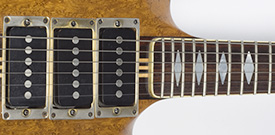
Teak’s Harmonic Design Z90’s.
All Teak and Ebony photos by Dan Savage
Armato: It had humbuckers and then you switched them out for Z90’s. What was the motivation?
Kimock: I have a lot of guitars with humbuckers already. I think the humbucker is a great pickup, but I think it is just as much a remedy for a problem, as anything. I think the single-coil is a more ideal representation of the guitars’ sound to me. I think it was Henry Kaiser that turned me on to the Z90’s. He said, “you gotta’ try these things.” Henry doesn’t jump up and down about stuff all that often, so when he told me about this pickup, I had to try them.
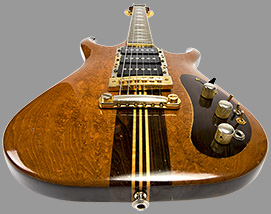
Cripe Teak.
Armato: Teak is one of the strongest woods in the world. Cripe probably used it in yachts both decoratively and because it could withstand dramatic environmental changes without warping. How do you think Teak contributes to the tonal characteristics of the guitar, if at all?
Kimock: It’s a very even guitar. Really just remarkably even, even for a neck-through. You can throw as many evens in there as you want.
That guitar has two qualities that I really thought would have been mutually exclusive in a guitar with that kind of construction, you know with the laminated neck-through the body. It’s super even, which kind of makes sense, but it has this beautiful, almost diffuse quality to it. It’s nowhere near as pointy. If there is a criticism just generally of the neck-through thing by some, they’re just not as warm and fuzzy or as organic as a bolt-on neck, with loose bolts. But, the teak guitar pretty much does anything you need it to do without ever being one dimensional in terms of attack or anything like that. It is a very natural sounding guitar.
Armato: What do you mean when you say it has a diffuse quality?
Kimock: It’s more diffuse than the standard. The Ebony guitar is a lot more on point with its’ attack. Right at the very front of the note, there is a real concentration of energy - the sound sort of stays with the rest of the note and the Teak guitar gets all that fundamental. But there is more action in the development of the note in that guitar.
Armato: The Teak has a battery for the pre-amp effects loop.
Kimock: It’s the same CB-1, pre-amp, non-phase-inverting, buffer thing that John Cutler designed for Jerry Garcia, however many years ago that first one came out. I tried a couple different pre- amps in it and a couple Cutler’s newer Jangle Tone things and so forth.
Armato: Teak is native to India. Some of your music has an Indian inflection to it. Does that guitar lend itself to that style more than any of your other guitars?
Kimock: No. I don’t think so. That’s an attitude I will take musically occasionally just because I’ve listen to enough of that music over the years, just casually, that I have…what’s the right word…
Armato: It’s more you than the guitar?
Kimock: Yeah. I’ve listened to that music since I was a teenager, so it’s internalized to a degree without it being specifically studied or gone to on a particular instrument. If I was an actual Sitarist or Sarodist or something like that, and was taking techniques from the music and instruments specific to them, I might have something more to say about it. But, no I’m a rock n’ roll guitar player.
Armato: And then along came Ebony. What was your first impression of it?
Kimock: It’s funny, because when it showed-up, my first impression was, Oh my God, I DO NOT need another guitar!

Photo by Janice Wulf |
 |
Armato: And another Cripe, nonetheless!
Kimock: I do not need another guitar. I have so many guitars! At the same time, I was overwhelmed because it was a gift, as well. Someone bought another one and said, let’s put this right and see where this goes. I was thinking, what was the point, really, in the duplication? When you get a good one of something, you decide you should have another, either as a backup, or take one on the road and keep one at home so it’s safe. Those ideas are based on the guitars being close enough in their performance that one would serve for the other. They are completely different guitars! They are nothing alike. The black one is a totally different tool. The Teak guitar is basically a paintbrush and the Ebony guitar is more of a knife.
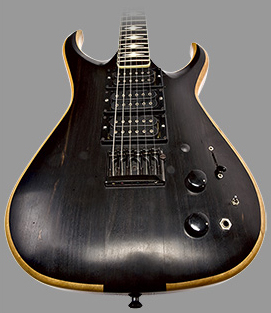
Cripe Ebony.
Armato: Ebony is a dark wood, does that translate into a darker tone?
Kimock: I don’t think it does. It might. I have a certain feeling about an instrument when I pick it up based on its appearance. You can’t help but engage all your senses when you pick it up and play it. There may be associations with a dark color and a dark sound. But, generally, I haven’t found that color and pitch, or color and that spectral content stuff to be on any one-to-one relationship.
Armato: There are guitars where the marriage feels just right with certain amplifiers and settings.
Kimock: There is no question about that. I prefer the Teak guitar through a cleaner amp because I think it has such a unique tone all by itself and I like to hear that. I don’t like to have that too mangled.
The Ebony guitar is pretty much fine through everything. It’s one of those guitars that just rocks no matter what you play it through. It doesn’t matter if you are playing it clean or with a bunch of distortion.
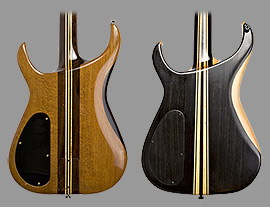
Seven and nine-ply laminated neck-through body design of Teak and Ebony respectively.
Armato: Both guitars have three layers of body wood and multi-ply laminated necks. Do you think that design effects the sustain of the guitar?
Kimock: Yeah, I’m sure it does. I have a Scott Walker instrument that he built for me a couple of years ago that’s got a very heavy neck-through with 24 frets. That has a similar sustain and by virtue of having greater weight, it carries more low-end, more fundamental, even more than the Cripes do. You couldn’t approach that kind of thing without the weight and stiffness that the laminations provide. You can do it to a certain degree just with stiffness. I have some instruments that are lighter weight that are very stiff that are in the ballpark but it’s not quite the same thing. The neck-through is its own thing for sure.
Armato: You’ve had the opportunity to play Garcia’s Irwin Guitars. How do you compare those with the Cripe guitars?
Kimock: Off the top of my head, it’s been awhile, I thought the Irwin’s were all just sort of heavier guitars. They felt big and they were more ornate in a lot of ways. Of course there were similar neck-through characteristics. Jerry had kind of an odd setup on the things. Action was pretty high and there was a lot of relief in the neck on all those instruments. That kind of leads the charge in terms of your impression of the instrument and I don’t set my guitars up like that. Garcia usually used lighter strings and higher action and I use heavier strings with slightly lower action, on those guitars at least, and prefer having the neck a little straighter.
Armato: What kind of legacy do you think Cripe left behind?
Kimock: I never thought about that question in those terms, but building those guitars for Garcia, and having Jerry adopt them as his main instrument, I don’t think you can ask for a whole lot more than that. I don’t know who else’s hands those instruments are in right now. I guess it remains to being seen if they pop up being played by other folks, and stay active. I’m hoping to keep them active myself.
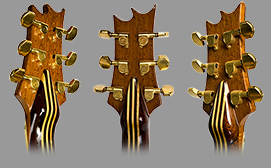
Teak’s Volute.
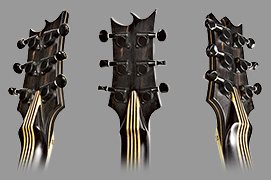
Ebony’s Volute.
Armato: Do you think the size of the volutes is more for stability and structural integrity or for sustain or what?
Kimock: The volutes on both the guitars are pretty pronounced.
I think you could probably get a significant increase in structural integrity across that part of the neck with a much smaller volute, particularly with the laminations in play. You wouldn’t need much just to stabilize that area. Any little bit would help.
It’s impossible to second-guess him. Who knows what the builders intention was. I think it may have been equal parts an attempt to strengthen that area of the neck, which was a great idea, and to get a little more physical balance to the instrument.
Both of my Cripe guitars are exceptionally well balanced. Ergonomically they are really rewarding to hold and play and present themselves on the strap both standing and sitting equally well. They are really both a joy to play. I can’t imagine changing any of the dimensions too much without losing some of that. That was probably the thing that struck me the most about both of those guitars, considering the builder himself wasn’t a big player or anything like that, he really, for me at least, made very, very physically comfortable guitars, very easy to play.
So, I’m guessing that the volute provides some balance, as well.
Armato: Thank you. Having listened to some of your recent downloads of live shows, sounds like you’re having a good time with Crazy Engine.
Kimock: I’m having a wonderful time, thank you.
Armato: I hope to catch you on the road.
Kimock: Very good. Stay in touch. Thank you very much.
|
